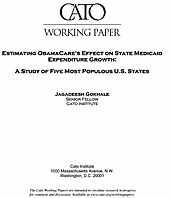The results suggest that Medicaid costs would increase considerably even on a pre-ObamaCare basis in California, Florida, and Texas — states with rising populations across many Medicaid eligibility and enrollment groups by age and gender. Cost increases on a pre-ObamaCare basis are projected to be smaller in Illinois and New York — states whose populations are projected to remain generally stagnant or decline during the next two decades. On a post-ObamaCare basis, the projected cost increase is small for California — just 4.5 percentage points in cumulative costs during 2014–23 compared to the pre-ObamaCare ten-year total cost projection. That’s because enrollment rates among “old-eligibles” are already high in California on a pre-ObamaCare basis, implying little scope for additional enrollment increases from the introduction of ObamaCare. In Florida and Texas, projected post-ObamaCare increases in Medicaid costs are larger, because these states are projected to have larger populations of non-enrolled “old eligibles.” Illinois and New York exhibit historically stable or declining enrollment rates among “old eligibles,” implying larger potentials for higher enrollments and increased costs when ObamaCare becomes effective after the year 2014.
Estimating ObamaCare’s Effect on State Medicaid Expenditure Growth
Unless repeal attempts succeed, the Patient Protection and Affordable Care Act of 2010 (ObamaCare) promises to increase state government obligations on account of Medicaid by expanding Medicaid eligibility and introducing an individual health insurance mandate for all US citizens and legal permanent residents. Once ObamaCare becomes fully effective in 2014, the cost of newly eligible Medicaid enrollees will be almost fully covered by the federal government through 2019, with federal financial support expected to be extended thereafter. But ObamaCare provides states with zero additional federal financial support for new enrollees among those eligible for Medicaid under the old laws. That makes increased state Medicaid costs from higher enrollments by “old-eligibles” virtually certain as they enroll into Medicaid to comply with the mandate to purchase health insurance. This study estimates and compares potential increases in Medicaid costs from ObamaCare for the five most populous states: California, Florida, Illinois, New York, and Texas.

